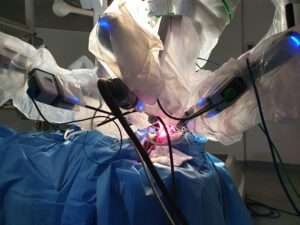The advancement in medical science and the development of newer surgical techniques have revolutionized the way cancer surgeries are performed nowadays. The advent of minimally invasive procedures has been a boon to cancer patients as they provide several benefits and are a safer and better alternative to conservative open surgery.
One such novel surgical procedure is Robotic-assisted breast-axillo insufflation thyroidectomy (RABIT). It is robotic surgery for removing the thyroid performed through minor incisions using robotic technology.
Dr. Sandeep Nayak, a renowned surgical oncologist in India, invented RABIT, a highly-advanced technique, in 2018 to treat thyroid cancer. Robotic thyroidectomy has been used since 2007, but RABIT is a more refined and advanced procedure which is considered the best and most versatile technique.
Dr. Sandeep Nayak is the founder of MACS Clinic, a technologically advanced centre for the best cancer treatment in Bangalore. Here, you are assured the highest standard of evidence-based cancer treatments using the most advanced surgical modalities like laparoscopic and robotic surgery.
Dr. Sandeep Nayak is a firm believer in minimal access cancer surgeries. He removes his valuable time to train other doctors so that the advanced surgical approach’s benefits reach more patients.
Till date, he has held training for doctors at 6 to 7 centres all over India, where he has performed this procedure live for them. As the technique is simpler than other techniques, many robotic surgeons have switched to the RABIT procedure in India.

 Patients now have new hope thanks to RABIT, which enables a more cutting-edge, innovative, and superior method for those who want a thyroidectomy without scars.
Patients now have new hope thanks to RABIT, which enables a more cutting-edge, innovative, and superior method for those who want a thyroidectomy without scars. Thyroid cancer starts in the thyroid, a butterfly-shaped gland in the neck. The thyroid, which is connected to the endocrine system, produces hormones that control heart rate, body temperature, and metabolism.
Thyroid cancer starts in the thyroid, a butterfly-shaped gland in the neck. The thyroid, which is connected to the endocrine system, produces hormones that control heart rate, body temperature, and metabolism.